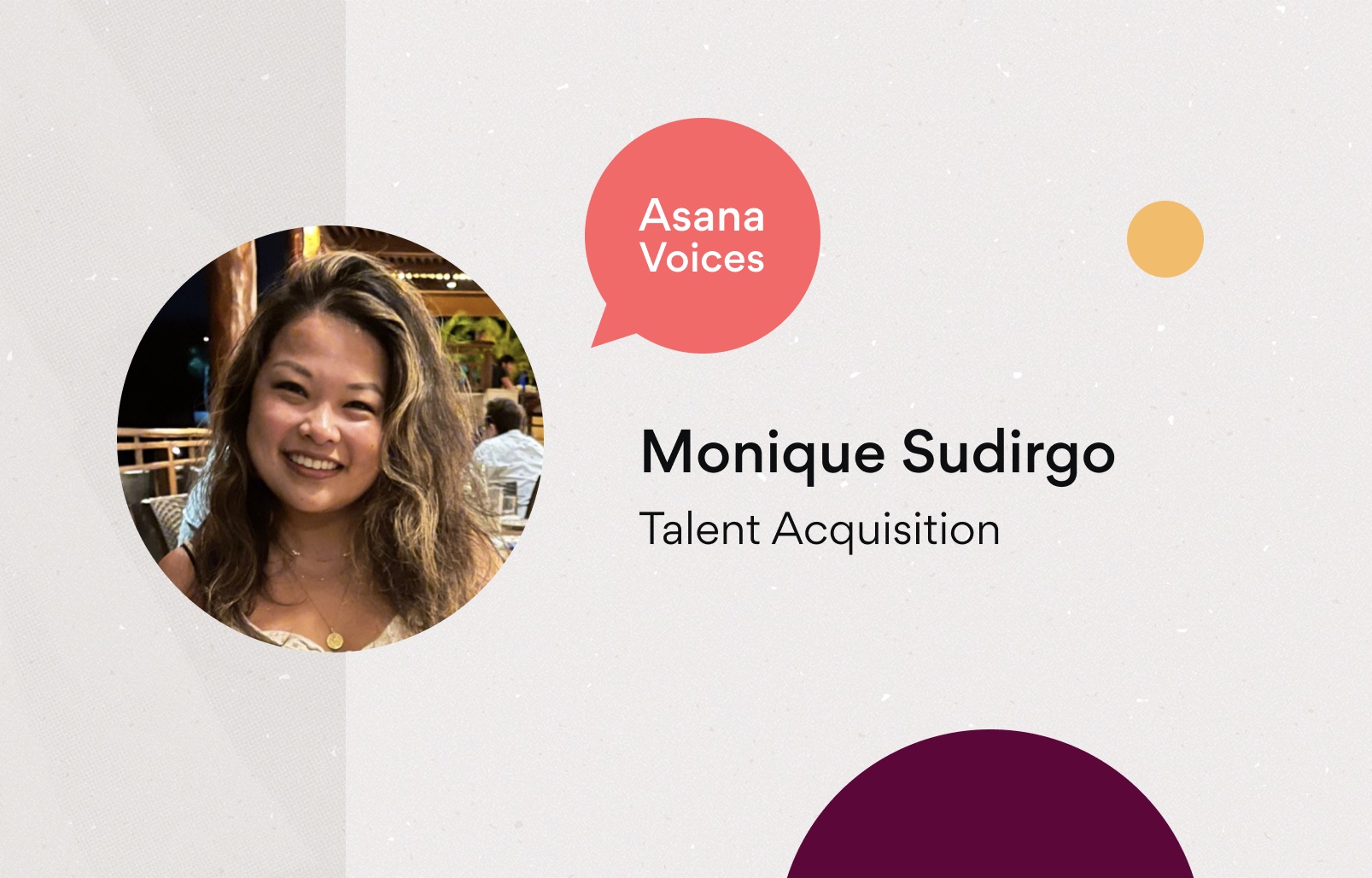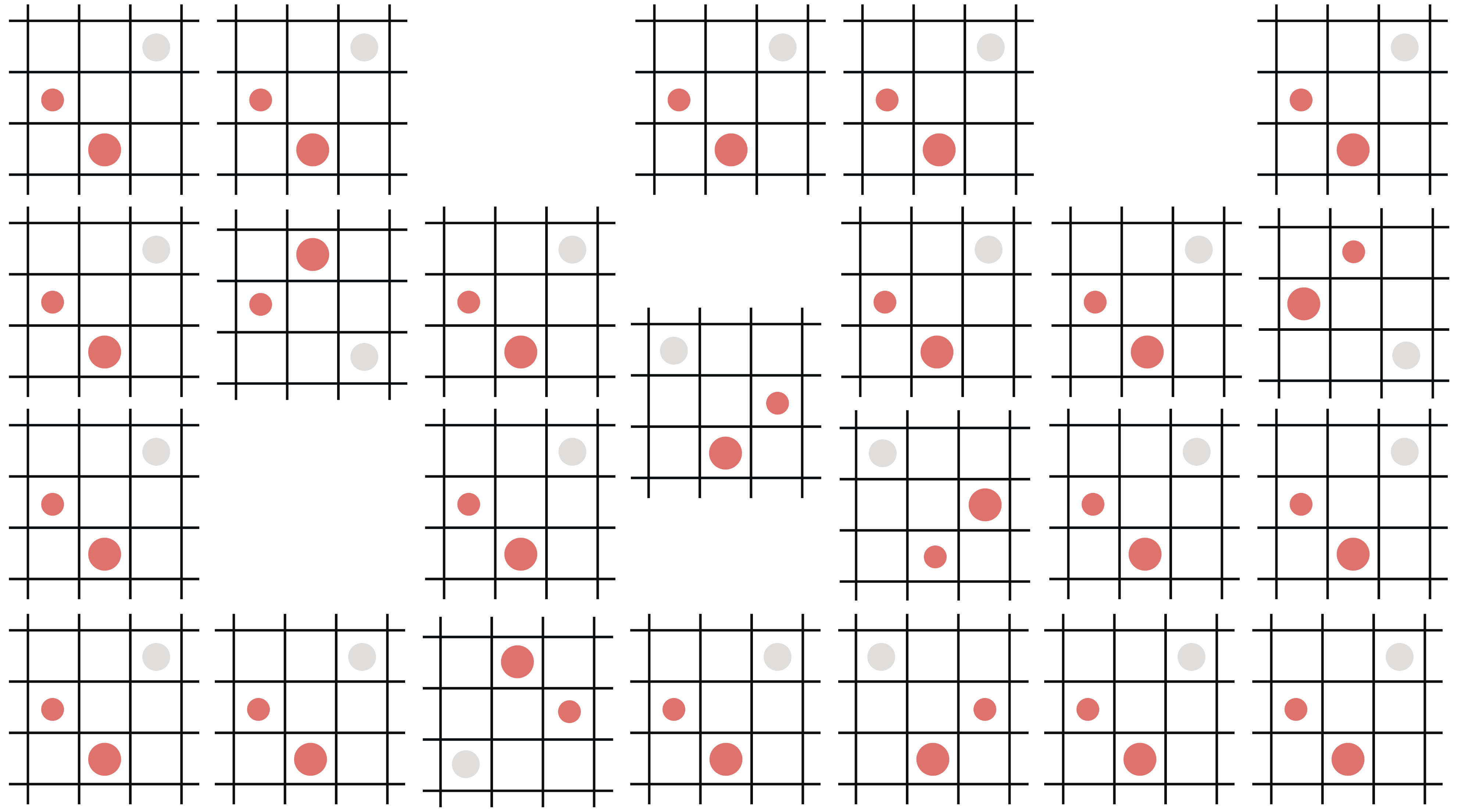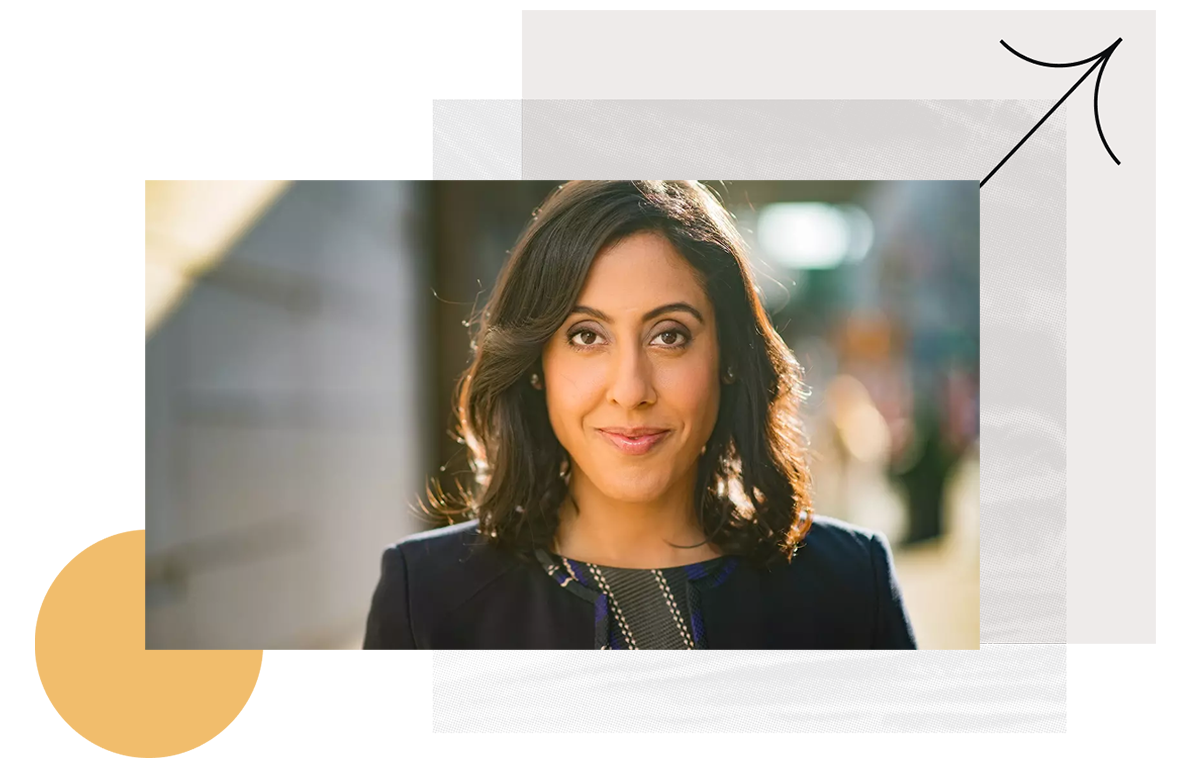Asana Voices: Meet Monique Sudirgo, Talent Acquisition team

Welcome to our new blog series, Asana Voices! With each post, we’ll feature one-on-one interviews with the talented individuals on our global team. You’ll get to know the people inside the company, including the twists and turns in their career journeys, what it’s really like working at Asana, and what they value most about their unique impact on our company, customers, and mission.
Meet Monique Sudirgo, a talent acquisition leader at Asana! Monique first joined the company as a recruiter supporting Engineering leadership, and now, nearly three years later, has built the General & Administrative (G&A) recruiting function from scratch managing a team of recruiters. Take a look inside Monique’s career journey and learn why she believes that Asana’s secret sauce is its investment in people.
What first attracted you to Asana? What has kept you here?
My Asana journey started when a former coworker reached out to me about an open role on the Talent Acquisition team. I was attracted to the opportunity to be the sole recruiter focused on hiring for leadership roles on our Engineering/Product team. I recall researching the Engineering leadership team at Asana at the time and being impressed by everyone’s tenure with the company. I think at the time, one of the shortest tenures was five years! That made me feel like there had to be something really special about the company for these leaders to choose to stay here for so long.
The thing that has kept me here is Asana’s investment in its employees. We do that through different programs like our (healthy) onsite culinary program, executive coaches, and meditation rooms in the office. But more importantly, Asana invests in hiring roles on the People team that are directly tied to the employee experience.
Asana is making investments in hiring for the People team at a much earlier inflection point than most other companies, like hiring a Diversity and Inclusion Lead when the company was less than 200 people, hiring for Organizational Strategy at around 500 people, and the list goes on. Being part of the hiring process for these types of roles has made me feel really connected to our mindfulness and intention behind sustaining and scaling our culture.
Asana also has an incredible executive coaching benefit available to all full-time employees. The company’s belief that all employees can benefit from coaching at every point in their professional careers is something I truly value. Both my manager and executive coach have pushed me to think about my own development beyond my current role and scope, which has impacted my own career growth at Asana.
“I feel valued at Asana knowing that the stakeholders and leaders I work with really value my expertise and input.”
What is something you’re particularly proud of that you’ve achieved at Asana?
One thing I’m particularly proud of goes back to my first role at Asana. The company was investing a lot more in the Engineering team’s growth and scale, particularly on the leadership side. When I came in, I focused on revamping our assessment process and building relationships with hiring managers.
I partnered with our org leaders on clearly defining role scope and pitch points, putting best practices in place for conducting strategic outreach, and streamlining our offer process. We were able to achieve some of the highest industry close rates from our partnership and efforts and hired a full bench of engineering leaders for the company that are all incredible people who have made a huge impact at Asana.
How has your career grown since joining the team?
I started out at Asana as an individual contributor (IC), focused on Engineering leadership, and had a lot of initial success there. So, with the support of my manager, I expanded the roles I was recruiting for and the breadth of my IC work, supporting a broader range of business functions. I spent about a year and a half doing that before moving into a new role, spinning off our G&A recruiting team (G&A at Asana represents internal-facing teams, including Legal, People, Talent Acquisition, Finance, Accounting, IT, Workplace, and Culinary teams).
I love that my team gets to hire for roles that help Asanas thrive. This has been a rewarding piece of my work here because that’s something I value about Asana as a company. Asana puts a lot of focus on making investments in people partly by ensuring our internal-facing teams are supported and resourced.

What was your state of work before using Asana, and what is your work like now that you have Asana?
Before I started using Asana, my work was much heavier in email. I’ve worked at companies that had work collaboration tools in place, but they barely scratched the surface. Now that I use Asana every day for all of my work, I have a lot more structure and organization in my day-to-day. It saves me a ton of time, and there’s a huge benefit to Asana helping to better enable others and share resources to make things consistent and efficient.
A lot of the things I do in Asana are not impossible to do via email or spreadsheet. But, those tools aren’t designed for collaboration. When you do it the old way, your work isn’t replicable the same way. When you write an email or create a spreadsheet, you can’t just create a template and duplicate it and use it over and over again. So there’s both a time and efficiency piece, but also distribution and sharing of those resources and materials is a lot easier as a manager and a leader.
For everything from one-on-one meetings to opening new roles, I’m able to keep all that information centralized in one place. For example, the Talent Acquisition team has created a lot of playbooks and resourcing in Asana as a tool. So as people are kicking off new roles and working with new hiring managers, they can leverage a template that breaks down all of the action items by role. And I think that’s probably the biggest area where I feel like it’s really impacted. My workflow allows me to easily enable other people.
How do you feel valued at Asana?
I feel valued knowing that the stakeholders and leaders I work with really value my expertise and input. They consult me for large decisions or hiring strategies. I’m grateful to have a manager who really trusts me and supports my growth. She encourages me to think about my own development, broadly and beyond my existing role and function.
How have you been supported and stayed connected to your team through working remotely?
Since the beginning of the pandemic and going remote, it was important to me to schedule time with people I work with regularly that are dedicated to connection, and not work. Not every interaction with your team has to be transactional! My team has virtual team lunches where no work talk is allowed, and I’m really rigid about it so that we use that time for connection.
In terms of feeling supported, the broader Talent Acquisition leadership team did the Enneagram assessment and had a guest facilitator come and help us dive deeper into what it means. That was incredibly rewarding and really allowed us to connect with one another and get to know each other’s communication and work styles a lot better.
What are you most looking forward to about working in-person from our offices?
Asana has grown so much, hiring and onboarding more than 500 people since the pandemic started last year. There are so many faces I haven’t seen before, and I’m just excited to connect in-person with them. We also have a brand new headquarters in San Francisco—a 12-story LEED-certified building with dedicated wellness zones and our Culinary program—that I’m so excited to see.
“Approaching things with curiosity and an openness to learn is something I value above all else.”
What’s your personal mantra, and where did it come from?
“Always walk through life as if you have something new to learn, and you will.” I really like this quote by Vernon Howard, a famous spiritual teacher and author. Approaching things with curiosity and an openness to learn is something I value above all else. It’s something I always look for when I interview people or when I’m hiring for my own team, and it’s served me well throughout my life.
If you could give a new Asana one piece of advice, what would it be?
Savor the onboarding process! Take that time to make connections with people in your onboarding class and in different functions and teams. Every Asana I have ever met has been so friendly and welcoming, and there’s a lot of value in building real connections with people outside of your work. Our onboarding program is the best I’ve ever experienced. I’m amazed at how the team has built in so many effective ways to drive deep virtual connections across time zones throughout the process.
Also, taking time to invest in setting up how you organize your Asana instance is priceless! As you jump into the work and your inbox starts to get more and more full, you’ll really wish you made that investment upfront in building and testing your workflows and learning how to make Asana work for you. I’ve continually iterated on how I organize my own Asana throughout my tenure here, and it really pays off in my productivity.
Take the next career-defining step in your journey at Asana! If you’re passionate about helping teams thrive and excited by the opportunity to make a big impact at a fast-growing company where an inclusive culture is non-negotiable, we’d love to talk to you. Apply today to join Monique on our Talent Acquisition team, or check out all our open roles across the globe.

